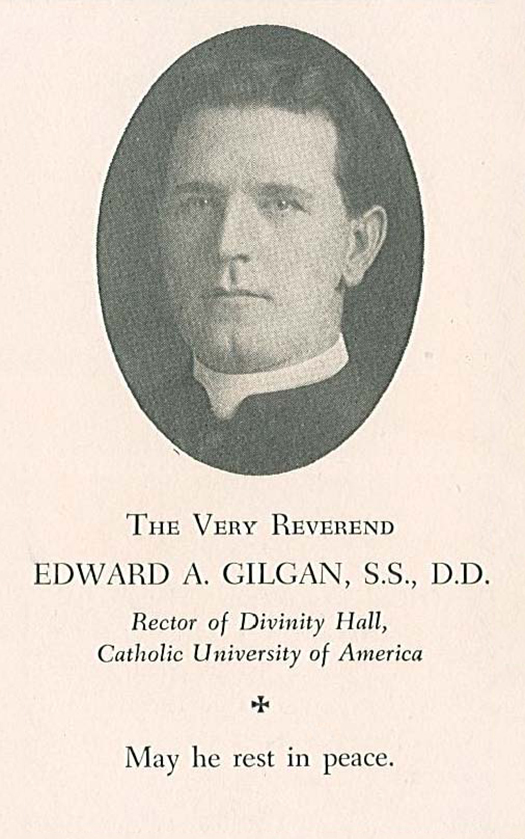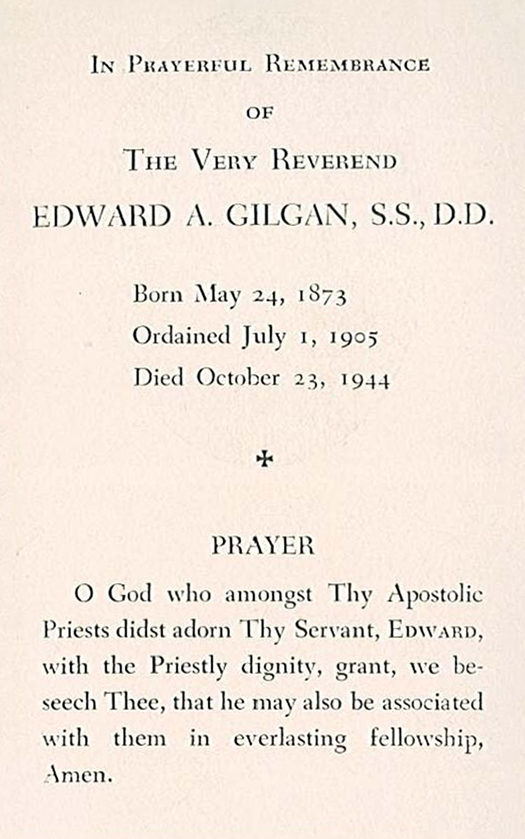Gilgan, Father Edward
1944, October 23
Date of Birth: 1873, May 23
Paris
March 21, 1946
Fathers and Dear Confreres:
In October, 1944, an American Sulpician, Father Edward Gilgan, died. He had for several years been in retirement because of his poor health.
Edward Augustine Gilgan was born on May 23, 1873, in New York at Fishkill on the Hudson. He was still a child when his family left that area to settle in New Jersey. He made his first studies in Jersey City, where he was a pupil at Mary’s School.
Since he wished to become a priest, his parents sent him to our minor seminary, St. Charles, which at the time was still in the vicinity of Ellicott City, Maryland. From there he went on to the major seminary, St. Mary’s in Baltimore, where he always showed himself an excellent seminarian. He was still there when death claimed the great Superior of that house, Father Magnien, very much admired by the American clergy.
Because he had expressed the wish of entering the Society of St. Sulpice, Father Dyer sent him to finish his theological studies at the Seminary of St. Sulpice in Paris. He was ordained priest in the Church of St. Sulpice on June 29, 1905, by Bishop Jourdan de la Passardière.
In October he entered the Solitude at Issy. We – his confreres of the time – remember that priest with his bearing always so dignified, his serious yet likeable character. He must have been hurting on finding himself so far from his country, but he never let on. His mind was clear, his heart was loving and full of goodness, his will was strong. Hence, he was always working; his piety was always giving more than it let itself take. His regularity was unfailing; his simplicity was such that self-seeking was never detectable in it the least.
On his return to the United States, Father Gilgan entered the Catholic University in Washington to work for a degree in Theology. There he received the licentiate. Later he earned his doctorate from St. Mary’s University [i.e., St. Mary’s Seminary].
Here is an account of his career and of the functions he fulfilled in our Society. From 1908 to 1914 he taught Dogmatic Theology at St. Patrick’s Seminary, Menlo Park in the Diocese of San Francisco. Called back to Washington, he became Treasurer of the student-priests’ seminary in Caldwell Hall at the Catholic University. At the same time, he taught Dogmatic Theology at the Sulpician Seminary in the same city at Brookland Station, close to the university. In 1924, when Father Fenlon became Superior of the Sulpician Seminary, Father Gilgan succeeded him as Superior of the university-seminary at Caldwell Hall. In this role, he was rather fortunate to inaugurate an organization whose purpose was the financing of study for young Sulpicians – an idea he had had for some years. To him also must go, in very large part, the credit for the fine house which serves as convent for the nuns who take care of the Sulpician Seminary.
Except for the years of illness at the end of his life, Father Gilgan’s Sulpician career saw its close in Washington.
There, as elsewhere, he acted as he had always done – as a serious man, as a man of God.
Really, to become such, he did not wait for priesthood. In his minor seminary years, while he was in his last year at St. Charles, his teachers selected him to be Prefect of Discipline for the Juniors. He showed himself, recounts one of his fellow-students of the time, capable of maintaining discipline because he was first of all self-disciplined. Even then, he had a very high ideal of priesthood. A man of duty of state, he knew that he was where he was by God’s Providence. He tolerated no breach of discipline and he knew how to reprimand, with unquestioned authority, the slightest infraction.
He was not concerned about his own popularity. He would have been deeply hurt to think that it was based on the slightest weakness or injustice. The boys were witnesses of his dealings, and they gave him the credit of asking nothing of others that he did not ask of himself. Already, at that early day, he was aware of what is necessary in priestly training.
Once assigned as teacher or superior in a seminary, Father Gilgan told himself – and with sound sense – that his example acted more powerfully and deeply on the students than his exhortations and classroom instructions. Every priest is more or less a model. But a priest who has the job of training seminarians is obliged to offer them in his person, his life style, and his actions the highest ideal of priesthood. His life must be a light and a guide for them. That priest must open to their inner selves the life of faith, must mold their hearts to the works of charity, must feed and strengthen their hope so that they may never become discouraged. It is a noble and heavy responsibility. From the dawn of his Sulpician life, Father Gilgan measured it, weighed it, accepted it; not at all as one accepts a crushing burden, but as one receives a commission which lends wings to him who carries it, embraces it with love even – and especially – when he finds in it the Cross: “Amor meus, pondus meum” [My love, my burden!]
It was there that lay the secret of the very deep influence that Father Gilgan exercised, and also the secret of the respect and trust that was his wherever he went.
Our Lord deigned to give a share of His Cross to His servant. This priest, with brilliant mind and untiring energy, little by little became stricken in body and mind. He had to cease his activity, refrain from work, succumb to total weariness. He had to give up; night fell on his spirit.
Happily, and thanks to the splendid care that he received, he came back to complete clarity of mind. The evidence is in this letter which he wrote to a family member a few days before his death:
“I am seventy-one years old. That amazes me, and I am spending my days in praying that God will soon call me to Himself in a holy and a happy death. I am disappointed and surprised that He has not already done so. I never expected to live this long.
“In spite of my weakness and my illness, I can still get up and with God’s help walk about in the hospital and continue – in some measure – to savor my good fortune. I pray for you every day, and I am confident that you are doing the same for me. May God bless you and keep you all well and happy. . . .”
A few days after he wrote that letter, Father Gilgan’s wish was granted; God called him to Himself.
Father Gilgan’s body was taken to Roland Park. It was there, in St. Mary’s Seminary, that the funeral of our confrere was held. The Requiem Mass was sung by Father Levatois, with Fathers Tennelly and Dwyer as deacon and subdeacon. As is customary in our seminaries, in the United States, a eulogy was preached – on this occasion by Father Jepson.
I surmise that the body was then brought to the little cemetery at St. Charles for burial there in the midst of those of us who worked with so much zeal and unselfishness in the training of the American clergy.
I recommend the dear deceased to your prayers, and I renew to you, Fathers and dear confreres, the expression of my fraternal affection in Our Lord.
P. Boisard
Superior General of the Society of St. Sulpice


